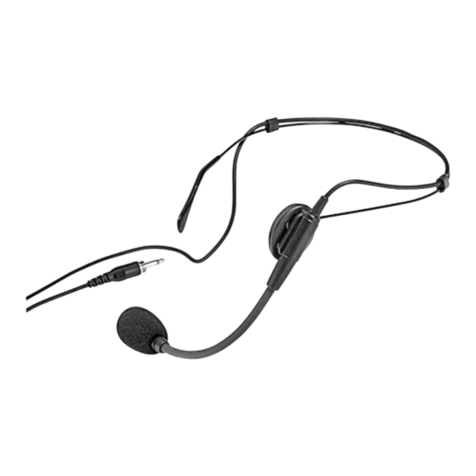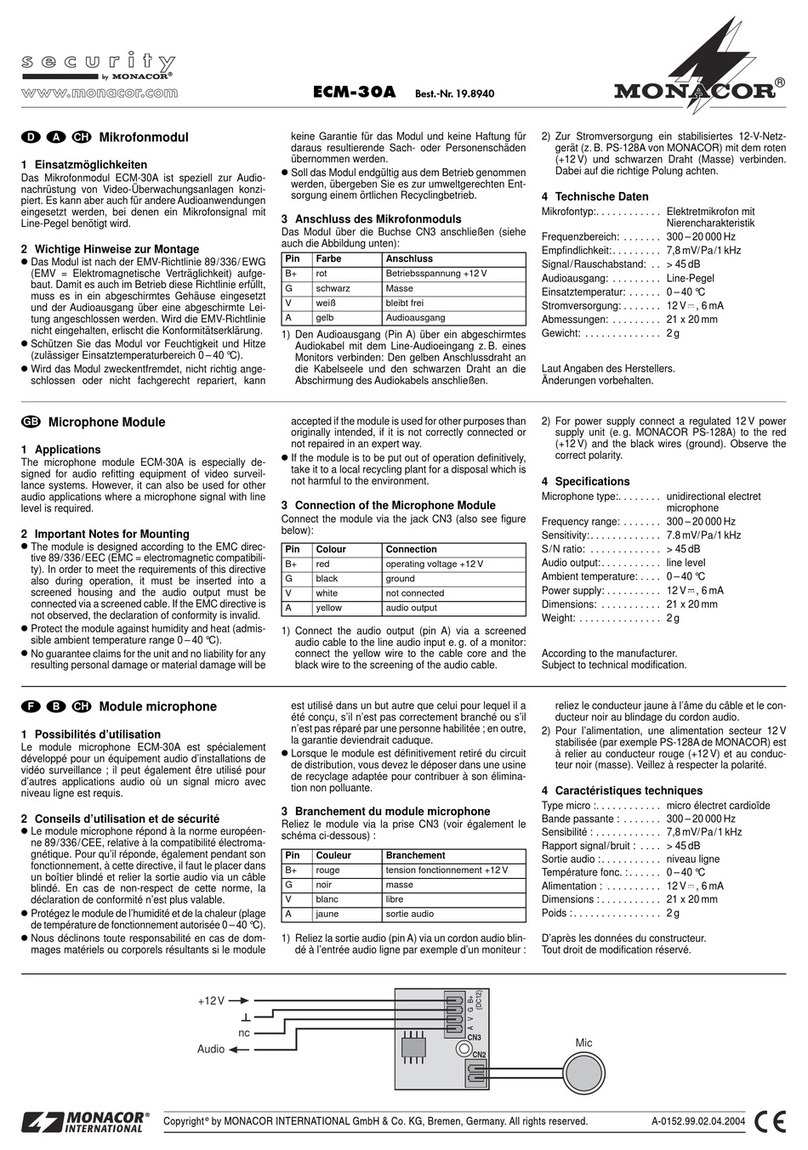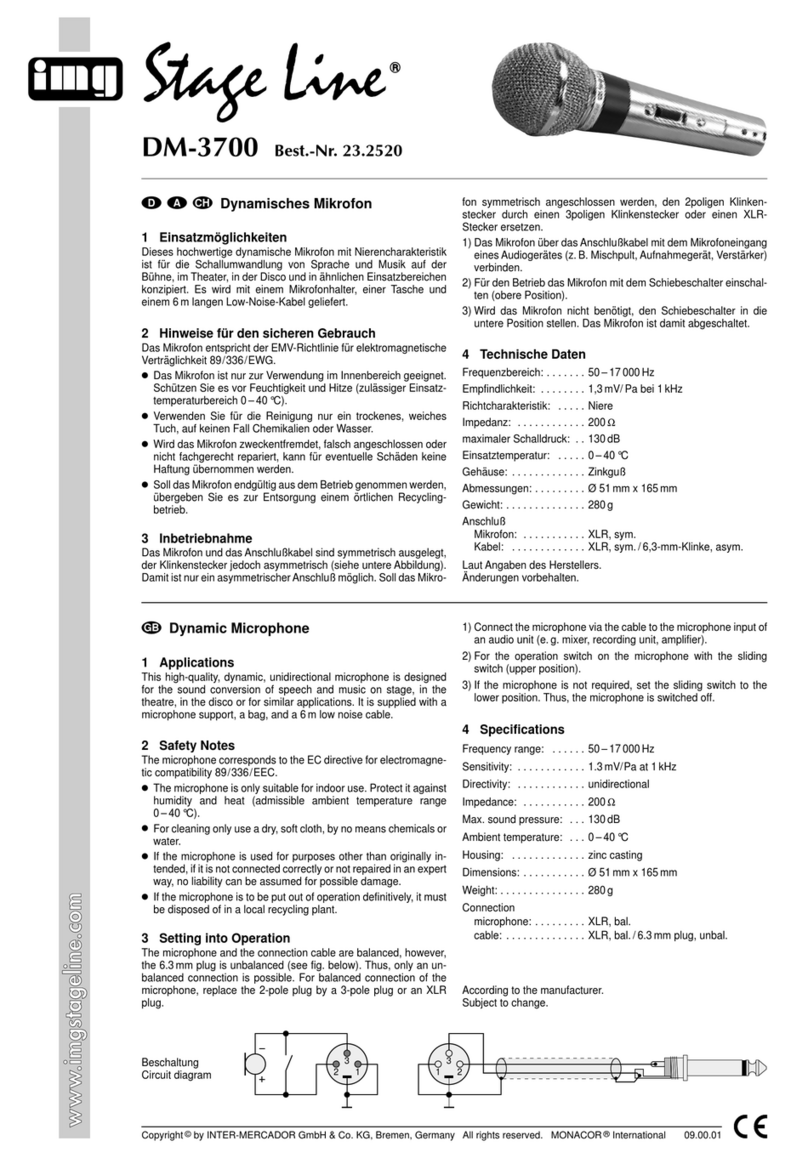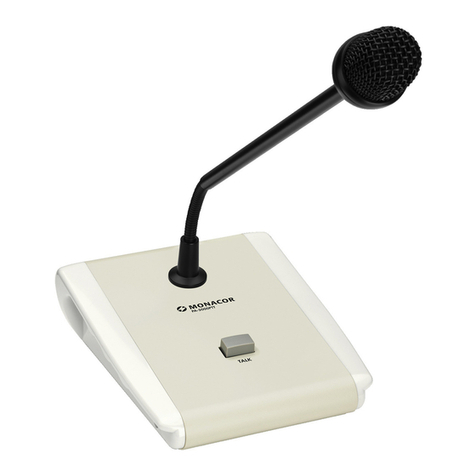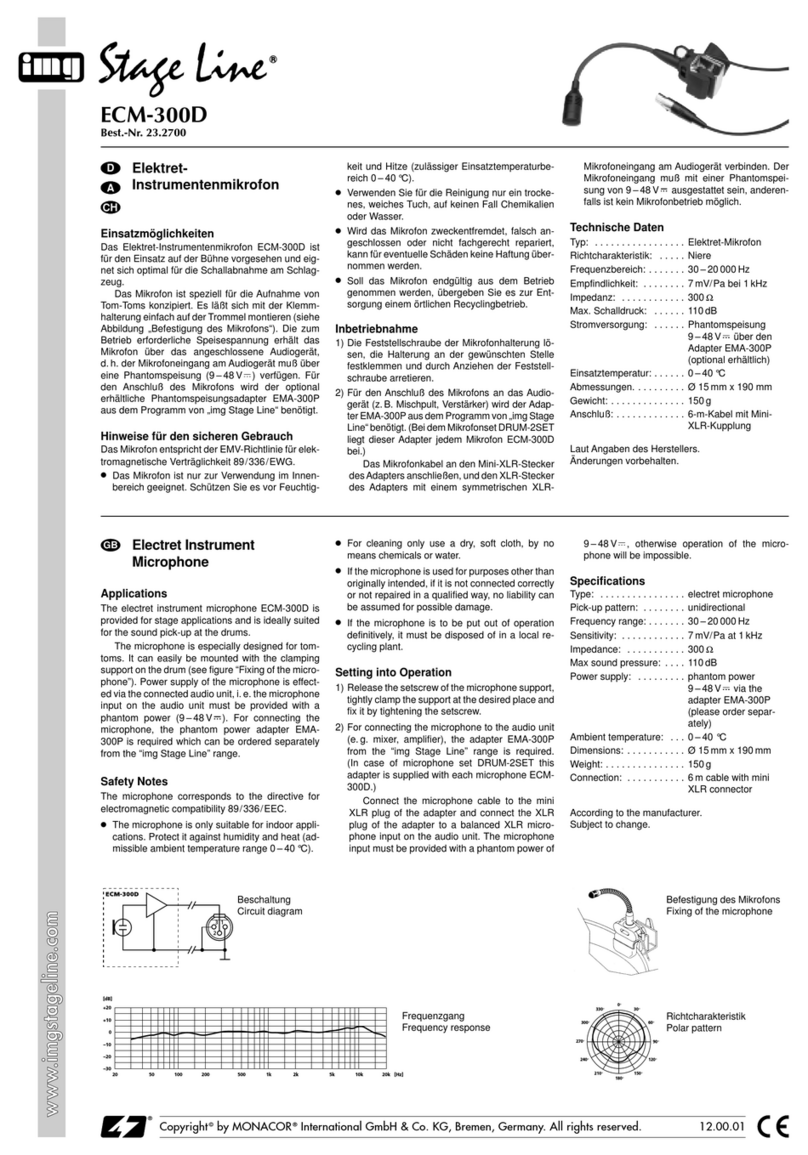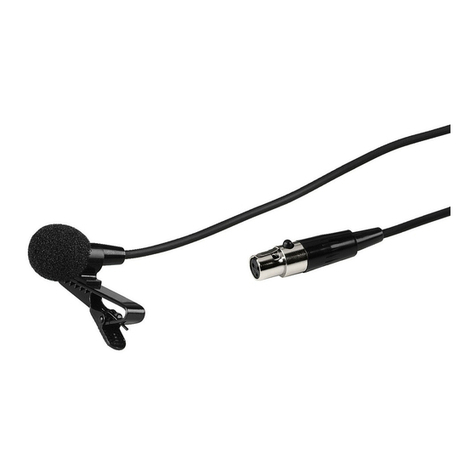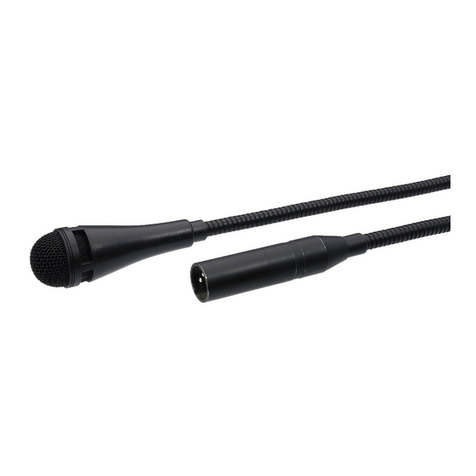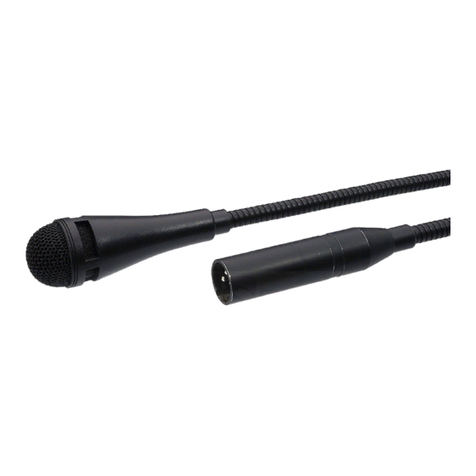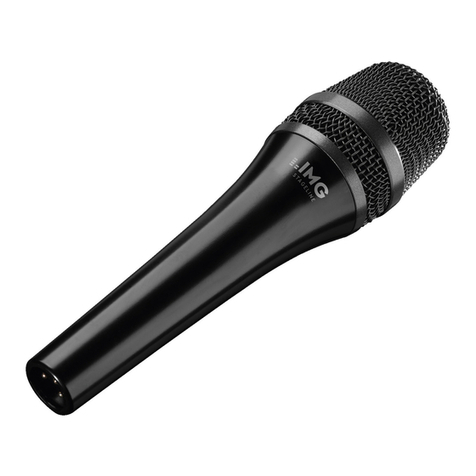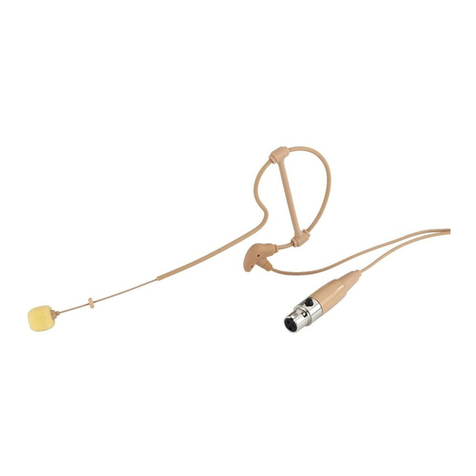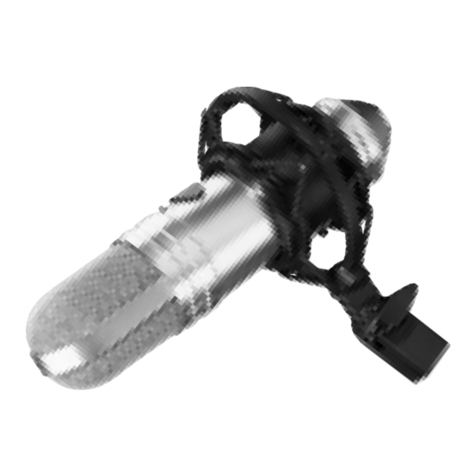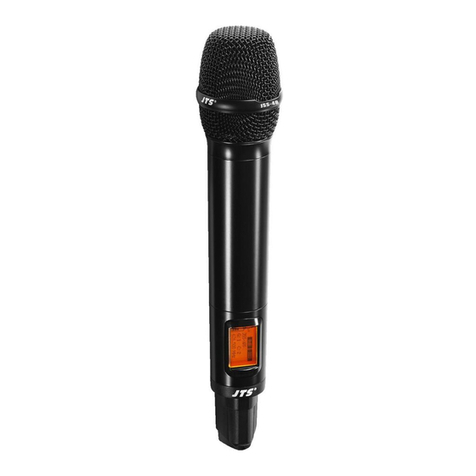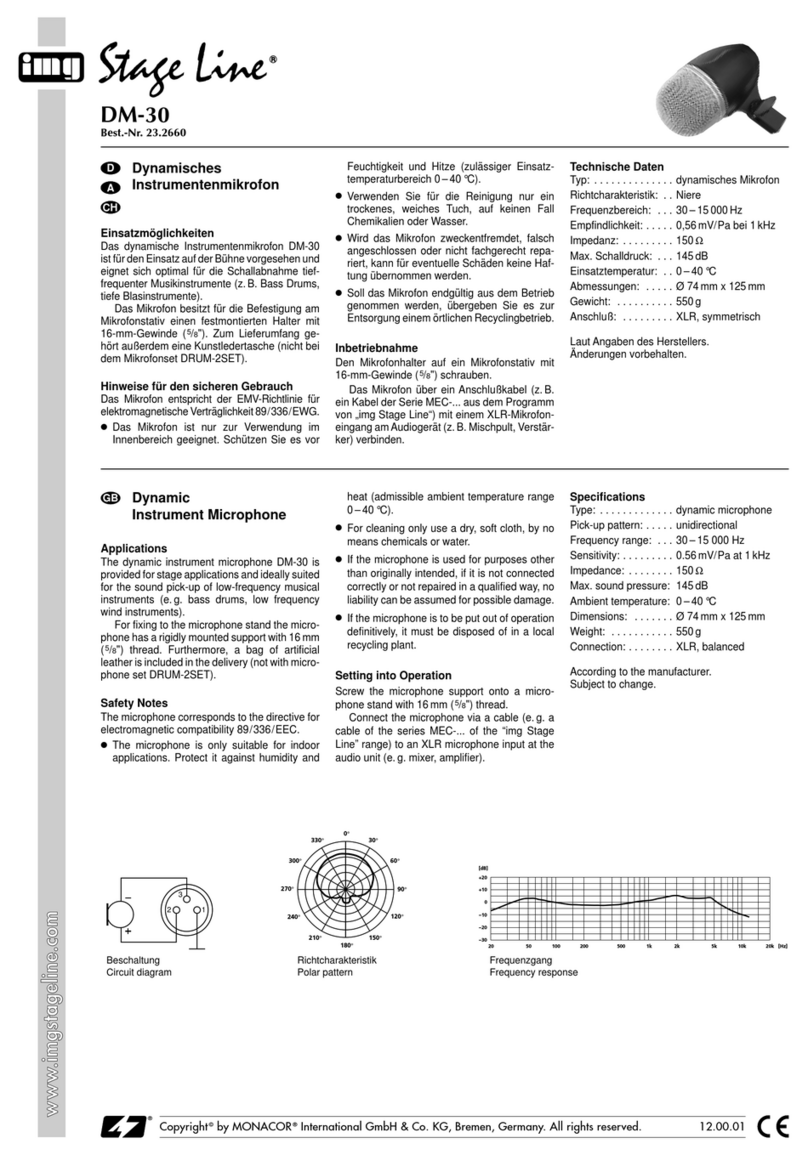
wwwwww..iimmggssttaaggeelliinnee..ccoomm
Kopfbügel-Mikrofon
1 Einsatzmöglichkeiten
Das Kopfbügel-Mikrofon HSE-80 eignet sich opti-
mal für Gesangs- und Sprachanwendungen, die viel
Bewegungsfreiheit erfordern, z. B. für den Einsatz
auf der Bühne oder beim Sport. Für den Betrieb wird
zusätzlich ein Speiseadapter (z. B. EMA-1, EMA-2,
EMA-40, EMA-300P) oder ein Taschensender
(TXS-...HSE) von „img Stage Line“ benötigt.
2 Wichtige Hinweise für den Gebrauch
Das Mikrofon entspricht allen erforderlichen Richtli-
nien der EU und ist deshalb mit gekennzeichnet.
GSetzen Sie das Mikrofon nur im Innenbereich ein
und schützen Sie es vor Feuchtigkeit und Hitze
(zulässiger Einsatztemperaturbereich 0 – 40 °C).
GVerwenden Sie für die Reinigung nur ein trocke-
nes, weiches Tuch, niemals Chemikalien oder
Wasser.
GWird das Mikrofon zweckentfremdet, falsch ange-
schlossen oder nicht fachgerecht repariert, kann
keine Haftung für daraus resultierende Sach-
oder Personenschäden und keine Garantie für
das Mikrofon übernommen werden.
3 Inbetriebnahme
1) Den Windschutz auf das Mikrofon setzen.
2) Den Mikrofonhalter in den Haken des Metallbü-
gels schieben und die beiden Kabelführungen so
am Bügel verschieben, dass das Mikrofonkabel
optimal am Bügel entlang geführt wird.
3) Den Bügel aufsetzen und das Mikrofon in eine
günstige Sprechposition bringen.
4) Die Mini-XLR-Kupplung des Mikrofonkabels mit
dem Mini-XLR-Anschluss am Taschensender
bzw. am Speiseadapter verbinden. Bei Verwen-
dung eines Speiseadapters diesen an den Mikro-
foneingang eines Audiogerätes anschließen.
Soll das Mikrofon endgültig aus dem
Betrieb genommen werden, übergeben
Sie es zur umweltgerechten Entsorgung
einem örtlichen Recyclingbetrieb.
4 Technische Daten
Typ: . . . . . . . . . . . . . . . . . Elektret-Mikrofon
Richtcharakteristik: . . . . . Niere
Frequenzbereich: . . . . . . 100 – 12 000 Hz
Impedanz: . . . . . . . . . . . . 2,2 kΩ
Empfindlichkeit: . . . . . . . 4,5 mV/Pa/1 kHz
Maximaler Schalldruck: . 110 dB
Signal-Rausch-Abstand: > 55 dB
Stromversorgung: . . . . . . 2 – 10 V
Gewicht: . . . . . . . . . . . . . 40 g
Anschluss: . . . . . . . . . . . 0,8-m-Kabel mit 3-pol.
Mini-XLR-Kupplung
1 = Masse
2 = Audiosignal
3 = Stromversorgung
Änderungen vorbehalten.
Headband Microphone
1 Applications
The headband microphone HSE-80 is ideally suited
for vocal sound and speech applications which re-
quire much freedom of movement, e. g. for the use
on stage or for sports events. For the operation, a
power supply adapter (e. g. EMA-1, EMA-2, EMA-
40, EMA-300P) or a pocket transmitter (TXS-...HSE)
from “img Stage Line” is additionally required.
2 Important Notes
The microphone corresponds to all required direc-
tives of the EU and is therefore marked with .
GThe microphone is suitable for indoor use only.
Protect it against humidity and heat (admissible
ambient temperature range 0 – 40 °C).
GFor cleaning only use a dry, soft cloth, by no
means chemicals or water.
GNo guarantee claims for the microphone or liabil-
ity for any resulting personal damage or material
damage will be accepted if the microphone is
used for other purposes than originally intended,
if it is not correctly connected, or not repaired in
an expert way.
3 Setting into Operation
1) Place the wind shield onto the microphone.
2) Slide the microphone support into the hook of the
metal bracket and displace the two cable guid-
ances at the bracket so that the microphone
cable is guided along the bracket in an optimum
way.
3) Put on the bracket and place the microphone into
a favourable talk position.
4) Connect the mini XLR inline jack of the micro-
phone cable to the mini XLR connection at the
pocket transmitter or at the power supply adapter.
When using a power supply adapter, connect it to
the microphone input of an audio unit.
If the microphone is to be put out of oper-
ation definitively, take it to a local recycling
plant for a disposal which is not harmful to
the environment.
4 Specifications
Type: . . . . . . . . . . . . . . . . electret microphone
Directivity: . . . . . . . . . . . . cardioid
Frequency range: . . . . . . 100 – 12 000 Hz
Impedance: . . . . . . . . . . . 2.2 kΩ
Sensitivity: . . . . . . . . . . . 4.5 mV/Pa/1 kHz
SPL max.: . . . . . . . . . . . . 110 dB
S/N ratio: . . . . . . . . . . . . > 55 dB
Power supply: . . . . . . . . . 2 – 10 V
Weight: . . . . . . . . . . . . . . 40 g
Connection: . . . . . . . . . . 0.8 m cable with 3-pole
mini XLR inline jack
1 = ground
2 = audio signal
3 = power supply
Subject to technical modification.
Microphone serre-tête
1 Possibilités dʼutilisation
Le microphone serre-tête HSE-80 est idéalement
adapté pour des applications de discours et de
chant requérant une grande liberté de mouvements,
par exemple pour une utilisation sur scène ou dans
le cadre dʼactivités sportives. Pour le fonctionne-
ment, un adaptateur dʼalimentation (par exemple
EMA-1, EMA-2, EMA-40 ou EMA-300P) ou un
émetteur de poche (TXS-…HSE) de “img Stage
Line” est en plus nécessaire.
2 Conseils importants dʼutilisation
Le microphone répond à toutes les directives né-
cessaires de lʼUnion européenne et porte donc le
symbole .
GLe microphone nʼest conçu que pour une utilisa-
tion en intérieur, protégez-le de lʼhumidité et de la
chaleur (plage de température de fonctionnement
autorisée 0 – 40 °C).
GPour le nettoyer, utilisez uniquement un chiffon
sec et doux, en aucun cas de produits chimiques
ou dʼeau.
GNous déclinons toute responsabilité en cas de
dommages matériels ou corporels résultants si le
microphone est utilisé dans un but autre que celui
pour lequel il a été conçu, sʼil nʼest pas correcte-
ment branché ou sʼil nʼest pas réparé par une per-
sonne habilitée ; en outre, la garantie deviendrait
caduque
.
3 Fonctionnement
1) Placez la bonnette anti-vent sur le microphone.
2) Poussez le support micro dans le crochet de
lʼétrier métallique et déplacez les deux guide
câbles sur lʼétrier de telle sorte que le câble du
micro courre de manière optimale le long de
lʼétrier.
3) Placez lʼétrier et mettez le microphone dans une
position de parole idoine.
4) Reliez la mini fiche XLR femelle du cordon micro
à la connexion mini XLR sur lʼémetteur de poche
Lorsque le microphone est définitivement
retiré du service, vous devez le déposer
dans une usine de recyclage adaptée pour
contribuer à son élimination non polluante.
ou sur lʼadaptateur dʼalimentation. Dans ce dernier
cas, reliez-le à lʼentrée micro dʼun appareil audio.
4 Caractéristiques techniques
Type : . . . . . . . . . . . . . . . microphone électret
Directivité : . . . . . . . . . . . cardioïde
Bande passante : . . . . . . 100 – 12 000 Hz
Impédance : . . . . . . . . . . 2,2 kΩ
Sensibilité : . . . . . . . . . . . 4,5 mV/Pa/1 kHz
Pression sonore max. : . . 110 dB
Rapport signal/bruit : . . . > 55 dB
Alimentation : . . . . . . . . . 2 – 10 V
Poids : . . . . . . . . . . . . . . 40 g
Branchement : . . . . . . . . cordon 0,8 m de long
avec mini XLR femelle
3 pôles
1 = masse
2 = signal audio
3 = alimentation
Tout droit de modification réservé.
HSE-80
Best.-Nr. 23.3880
®
MONACOR INTERNATIONAL GmbH & Co. KG
•
Zum Falsch 36
•
28307 Bremen
•
Germany
Copyright
©
by MONACOR INTERNATIONAL. All rights reserved. A-0347.99.02.01.2013
GB
D A CH
F B CH
